Historical Photos And The Stories Behind Them
Nathan Johnson
Published
10/25/2016
in
wow
you might learn something
- List View
- Player View
- Grid View
Advertisement
-
1.
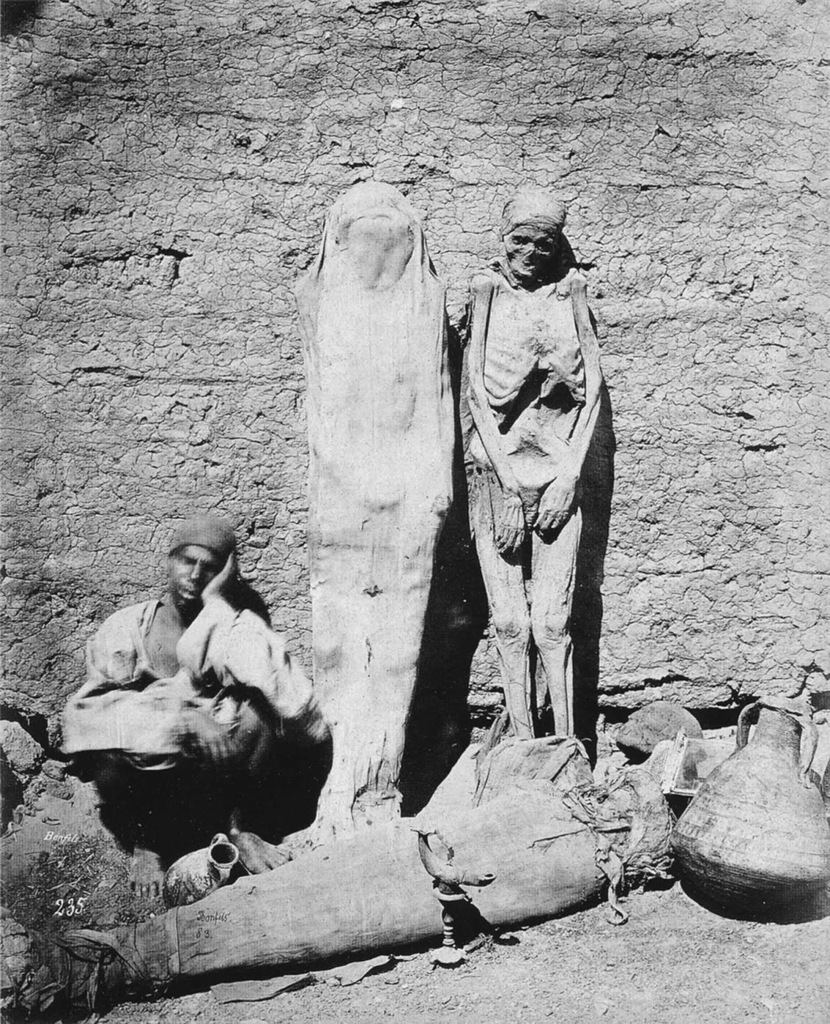 Street vendor selling mummies in Egypt, 1865. During the Victorian era of 1800’s, Napoleon’s conquest of Egypt threw open the Gates of Egypt’s history for the Europeans. At that time, mummies were not accorded the respect that they deserved from the European elites and in fact, mummies could be purchased from street vendors (as shown in picture) to be used as the main event for parties and social gatherings that took place in the 18th century. The elites of the era would often hold “Mummy Unwrapping Parties”, which, as the name suggests, had the main theme in which a Mummy would be unwrapped in front of a boisterous audience, cheering and applauding at the same time. During that period of time, the well-preserved remains of ancient Egyptians were routinely ground into powder and consumed as a medicinal remedy. Indeed, so popular was pulverized mummy that it even instigated a counterfeit trade to meet demand, in which the flesh of beggars was passed off as that of ancient mummified Egyptians. As the Industrial Revolution progressed, so Egyptian mummies were exploited for more utilitarian purposes: huge numbers of human and animal mummies were ground up and shipped to Britain and Germany for use as fertilizer. Others were used to create mummy brown pigment or were stripped of their wrappings, which were subsequently exported to the US for use in the paper-making industry. The author Mark Twain even reported that mummies were burnt in Egypt as locomotive fuel. As the nineteenth century advanced, mummies became prized objects of display and scores of them were purchased by wealthy European and American private collectors as tourist souvenirs. For those who could not afford a whole mummy, disarticulated remains – such as a head, hand or foot – could be purchased on the black market and smuggled back home. So brisk was the trade in mummies to Europe that even after ransacking tombs and catacombs there just were not enough ancient Egyptian bodies to meet the demand. And so fake mummies were fabricated from the corpses of the executed criminals, the aged, the poor and those who had died from hideous diseases, by burying them in the sand or stuffing them with bitumen and exposing them to the sun.
Street vendor selling mummies in Egypt, 1865. During the Victorian era of 1800’s, Napoleon’s conquest of Egypt threw open the Gates of Egypt’s history for the Europeans. At that time, mummies were not accorded the respect that they deserved from the European elites and in fact, mummies could be purchased from street vendors (as shown in picture) to be used as the main event for parties and social gatherings that took place in the 18th century. The elites of the era would often hold “Mummy Unwrapping Parties”, which, as the name suggests, had the main theme in which a Mummy would be unwrapped in front of a boisterous audience, cheering and applauding at the same time. During that period of time, the well-preserved remains of ancient Egyptians were routinely ground into powder and consumed as a medicinal remedy. Indeed, so popular was pulverized mummy that it even instigated a counterfeit trade to meet demand, in which the flesh of beggars was passed off as that of ancient mummified Egyptians. As the Industrial Revolution progressed, so Egyptian mummies were exploited for more utilitarian purposes: huge numbers of human and animal mummies were ground up and shipped to Britain and Germany for use as fertilizer. Others were used to create mummy brown pigment or were stripped of their wrappings, which were subsequently exported to the US for use in the paper-making industry. The author Mark Twain even reported that mummies were burnt in Egypt as locomotive fuel. As the nineteenth century advanced, mummies became prized objects of display and scores of them were purchased by wealthy European and American private collectors as tourist souvenirs. For those who could not afford a whole mummy, disarticulated remains – such as a head, hand or foot – could be purchased on the black market and smuggled back home. So brisk was the trade in mummies to Europe that even after ransacking tombs and catacombs there just were not enough ancient Egyptian bodies to meet the demand. And so fake mummies were fabricated from the corpses of the executed criminals, the aged, the poor and those who had died from hideous diseases, by burying them in the sand or stuffing them with bitumen and exposing them to the sun. -
2.
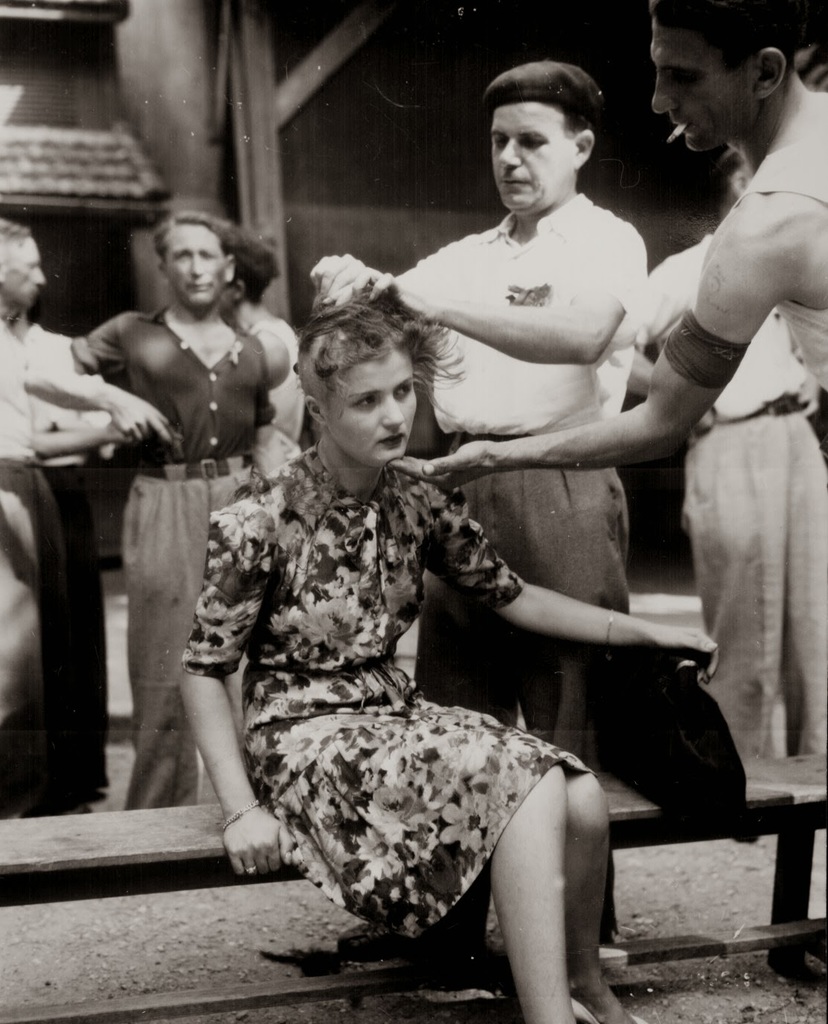 French female collaborator punished by having her head shaved to publicly mark her, 1944. French women who befriended the Nazis, through coerced, forced, or voluntary relationships, were singled out for shameful retribution following the liberation of France. The woman photographed here, believed to have been a prostitute who serviced German occupiers, is having her head shaved by French civilians to publicly mark her. This picture was taken in Montelimar, France, August 29, 1944. At the end of World War II, many French people accused of collaboration with Germany endured a particularly humiliating act of revenge: their heads were shaved in public. Nearly all those punished were women. Most historians have stressed the sexual anxiety created by the Nazi Occupation and how women’s sexual activity was judged as part of a public “cleansing” after liberation. Similar to the vigilante gangs that punished men who collaborated with the occupiers, groups would band together to judge women by parading them in the public square. This episode in French history continues to provoke shame and unease and as a result has never been subject of a thorough examination. Throughout France, from 1943 to the beginning of 1946, about 20,000 women of all ages and all professions who were accused of having collaborated with the occupying Germans had their heads shaved. Just as the identity of those who carried this task out varied so too did the form it took. For example, among those who carried it out can be found members of the Resistance, those who took part in fighting at the time of the Liberation, neighbors who came down into the street once the Germans had left and men whose authority depended on the police and the courts. All of them carried out this violent deed either behind closed doors, inside the walls of a prison or the home of the women so punished, or in a public square. If, in the last instance, it was men who wielded the scissors and the clippers, the population as a whole – men, women and children – were present at the event, which was both a spectacle and a demonstration of the punishment to be meted out to traitors.
French female collaborator punished by having her head shaved to publicly mark her, 1944. French women who befriended the Nazis, through coerced, forced, or voluntary relationships, were singled out for shameful retribution following the liberation of France. The woman photographed here, believed to have been a prostitute who serviced German occupiers, is having her head shaved by French civilians to publicly mark her. This picture was taken in Montelimar, France, August 29, 1944. At the end of World War II, many French people accused of collaboration with Germany endured a particularly humiliating act of revenge: their heads were shaved in public. Nearly all those punished were women. Most historians have stressed the sexual anxiety created by the Nazi Occupation and how women’s sexual activity was judged as part of a public “cleansing” after liberation. Similar to the vigilante gangs that punished men who collaborated with the occupiers, groups would band together to judge women by parading them in the public square. This episode in French history continues to provoke shame and unease and as a result has never been subject of a thorough examination. Throughout France, from 1943 to the beginning of 1946, about 20,000 women of all ages and all professions who were accused of having collaborated with the occupying Germans had their heads shaved. Just as the identity of those who carried this task out varied so too did the form it took. For example, among those who carried it out can be found members of the Resistance, those who took part in fighting at the time of the Liberation, neighbors who came down into the street once the Germans had left and men whose authority depended on the police and the courts. All of them carried out this violent deed either behind closed doors, inside the walls of a prison or the home of the women so punished, or in a public square. If, in the last instance, it was men who wielded the scissors and the clippers, the population as a whole – men, women and children – were present at the event, which was both a spectacle and a demonstration of the punishment to be meted out to traitors. -
3.
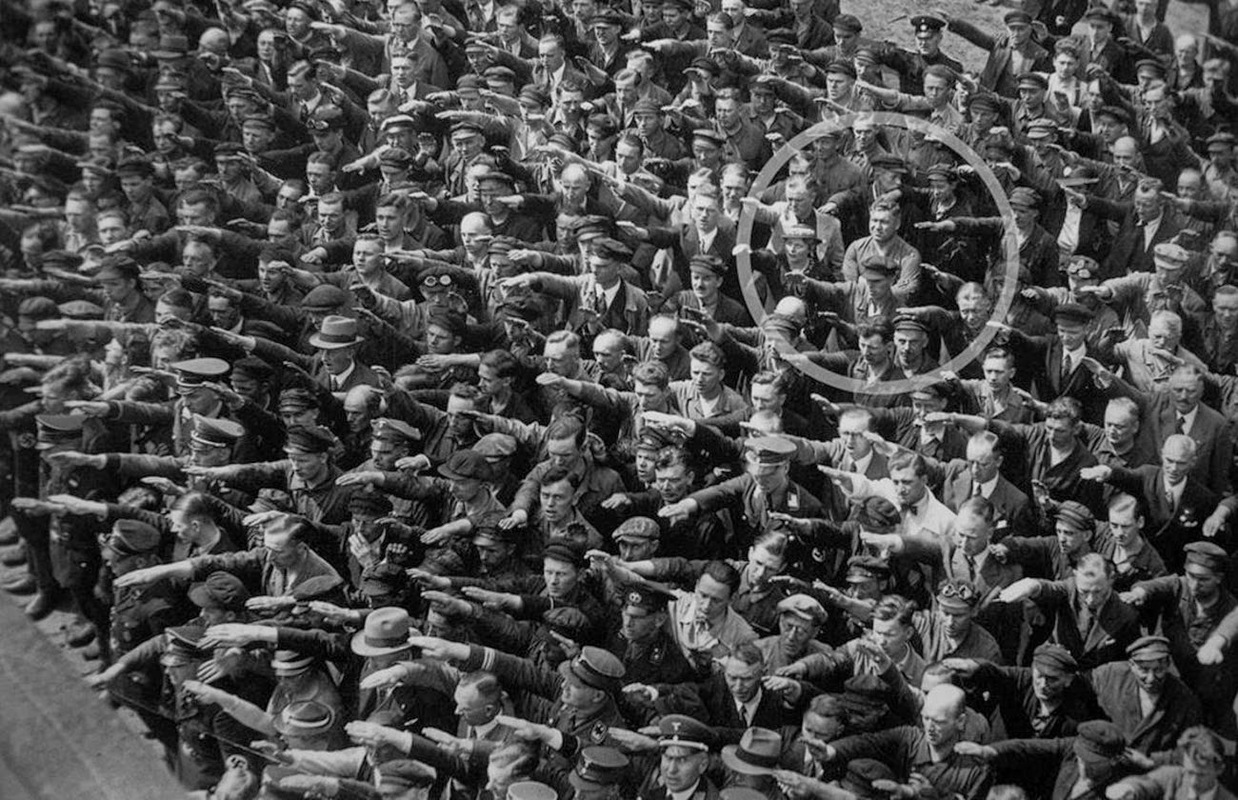 A lone man refusing to do the Nazi salute, 1936. The photo was taken at the launch of a German army vessel in 1936, during a ceremony that was attended by Adolf Hitler himself. Within the picture a lone man stood with arms crossed as hundreds of men and women around him held up their arms in salute and allegiance to the Nazi Party and its leader, Adolph Hitler. Everyone in attendance is showing their undying support for Der Fuhrer by throwing out their very best “Sieg Heil.” August Landmesser, grimacing with arms crossed, stood strong and defiant as he showed his disapproval by not displaying support for the Nazi Party. What made this photo and Landmesser’s defiance unique is that it represented the protest of one man, in its most sincere and pure form. The source of Landmesser’s protest, like many great tragedies, starts with a love story. The story of August Landmesser’s anti-gesture begins, ironically enough, with the Nazi Party. Believing that having the right connections would help land him a job in the pulseless economy, Landmesser joined the Nazi Party in 1931. Little did he know that his heart would soon ruin any progress that his superficial political affiliation might have made. In 1934, Landmesser met Irma Eckler, a Jewish woman, and the two fell deeply in love. Their engagement a year later got him expelled from the party, and their marriage application was denied under the newly enacted racial Nuremberg Laws. They had a baby girl, Ingrid, in October of the same year, and two years later in 1937, the family made a failed attempt to flee to Denmark, where they were apprehended at the border. August was arrested and charged for “dishonoring the race” under Nazi racial law. He argued that neither he nor Eckler knew that she was fully Jewish, and was acquitted on 27 May 1938 for lack of evidence, with the warning that a repeat offense would result in a multi-year prison sentence. The couple publicly continued their relationship and a month later August Landmesser would be arrested again and sentenced to hard labor for two years in a concentration camp. He would never see his beloved wife again. Eckler was detained by the Gestapo and held at the prison Fuhlsbüttel, where she gave birth to a second daughter Irene. Their children were initially taken to the city orphanage. Ingrid was later allowed to live with her maternal grandmother; Irene went to the home of foster parents in 1941. Later, after her grandmother’s death in 1953, Ingrid was also placed with foster parents. A few letters came from Irma Eckler until January 1942. It is believed that she was taken to the so-called Bernburg Euthanasia Centre in February 1942, where she was among the 14,000 killed. In the course of post-war documentation, in 1949 she was pronounced legally dead, with a date of 28 April 1942. The first and only photo of the family, June 1938. Although it was forbidden for them to meet, they appeared together in public and put themselves at exceptional risk. The first and only photo of the family, June 1938. Although it was forbidden for them to meet, they appeared together in public and put themselves at exceptional risk. August would be released in 1941 and began work as a foreman. Two years later, as the German army became increasingly mired by its desperate circumstances, Landmesser would be drafted into a penal infantry along with thousands of other men. He would go missing in Croatia where it is presumed he died, six months before Germany would officially surrender. His body was never recovered. Like Eckler, he was declared legally dead in 1949.
A lone man refusing to do the Nazi salute, 1936. The photo was taken at the launch of a German army vessel in 1936, during a ceremony that was attended by Adolf Hitler himself. Within the picture a lone man stood with arms crossed as hundreds of men and women around him held up their arms in salute and allegiance to the Nazi Party and its leader, Adolph Hitler. Everyone in attendance is showing their undying support for Der Fuhrer by throwing out their very best “Sieg Heil.” August Landmesser, grimacing with arms crossed, stood strong and defiant as he showed his disapproval by not displaying support for the Nazi Party. What made this photo and Landmesser’s defiance unique is that it represented the protest of one man, in its most sincere and pure form. The source of Landmesser’s protest, like many great tragedies, starts with a love story. The story of August Landmesser’s anti-gesture begins, ironically enough, with the Nazi Party. Believing that having the right connections would help land him a job in the pulseless economy, Landmesser joined the Nazi Party in 1931. Little did he know that his heart would soon ruin any progress that his superficial political affiliation might have made. In 1934, Landmesser met Irma Eckler, a Jewish woman, and the two fell deeply in love. Their engagement a year later got him expelled from the party, and their marriage application was denied under the newly enacted racial Nuremberg Laws. They had a baby girl, Ingrid, in October of the same year, and two years later in 1937, the family made a failed attempt to flee to Denmark, where they were apprehended at the border. August was arrested and charged for “dishonoring the race” under Nazi racial law. He argued that neither he nor Eckler knew that she was fully Jewish, and was acquitted on 27 May 1938 for lack of evidence, with the warning that a repeat offense would result in a multi-year prison sentence. The couple publicly continued their relationship and a month later August Landmesser would be arrested again and sentenced to hard labor for two years in a concentration camp. He would never see his beloved wife again. Eckler was detained by the Gestapo and held at the prison Fuhlsbüttel, where she gave birth to a second daughter Irene. Their children were initially taken to the city orphanage. Ingrid was later allowed to live with her maternal grandmother; Irene went to the home of foster parents in 1941. Later, after her grandmother’s death in 1953, Ingrid was also placed with foster parents. A few letters came from Irma Eckler until January 1942. It is believed that she was taken to the so-called Bernburg Euthanasia Centre in February 1942, where she was among the 14,000 killed. In the course of post-war documentation, in 1949 she was pronounced legally dead, with a date of 28 April 1942. The first and only photo of the family, June 1938. Although it was forbidden for them to meet, they appeared together in public and put themselves at exceptional risk. The first and only photo of the family, June 1938. Although it was forbidden for them to meet, they appeared together in public and put themselves at exceptional risk. August would be released in 1941 and began work as a foreman. Two years later, as the German army became increasingly mired by its desperate circumstances, Landmesser would be drafted into a penal infantry along with thousands of other men. He would go missing in Croatia where it is presumed he died, six months before Germany would officially surrender. His body was never recovered. Like Eckler, he was declared legally dead in 1949. -
4.
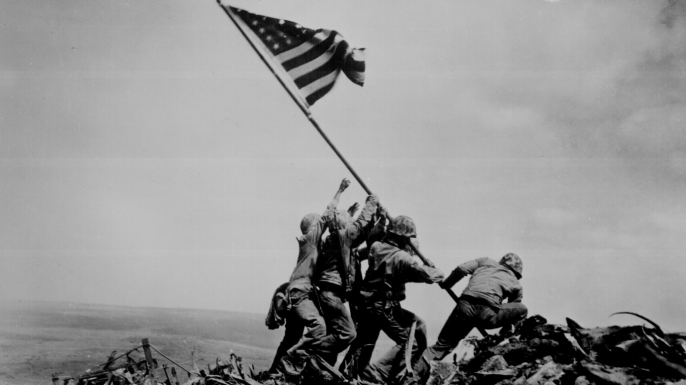 “Raising the Flag on Iwo Jima,” 1945, Mt. Suribachi. On February 23, 1945, Associated Press photographer Joe Rosenthal shot this photo of five Marines and one Navy corpsman raising a U.S. flag on Mt. Suribachi, the highest point on the Japanese island of Iwo Jima. The battle, one of the bloodiest in Marine Corps history, began on February 19, 1945, when the Americans invaded the heavily fortified island; four days later, they seized it and planted a small flag atop Mt. Suribachi. However, later that same day, the flag was ordered replaced with a much larger one that could be seen by troops across the island and on ships offshore. Rosenthal’s photo shows this second raising of the Stars and Stripes. The combat photographer subsequently was accused of staging the dramatic picture, but he denied the charge and eyewitnesses backed him up. The widely reproduced photo became a powerful patriotic symbol and went on to win a Pulitzer Prize and serve as the model for the Marine Corps War Memorial near Arlington National Cemetery. Three of the Marines in the photo were killed in action on Iwo Jima (the battle didn’t officially end until March 26, 1945), while the three surviving flag-raisers were sent back to the U.S., where they were treated as heroes and appeared at rallies across the country to promote the sale of war bonds.
“Raising the Flag on Iwo Jima,” 1945, Mt. Suribachi. On February 23, 1945, Associated Press photographer Joe Rosenthal shot this photo of five Marines and one Navy corpsman raising a U.S. flag on Mt. Suribachi, the highest point on the Japanese island of Iwo Jima. The battle, one of the bloodiest in Marine Corps history, began on February 19, 1945, when the Americans invaded the heavily fortified island; four days later, they seized it and planted a small flag atop Mt. Suribachi. However, later that same day, the flag was ordered replaced with a much larger one that could be seen by troops across the island and on ships offshore. Rosenthal’s photo shows this second raising of the Stars and Stripes. The combat photographer subsequently was accused of staging the dramatic picture, but he denied the charge and eyewitnesses backed him up. The widely reproduced photo became a powerful patriotic symbol and went on to win a Pulitzer Prize and serve as the model for the Marine Corps War Memorial near Arlington National Cemetery. Three of the Marines in the photo were killed in action on Iwo Jima (the battle didn’t officially end until March 26, 1945), while the three surviving flag-raisers were sent back to the U.S., where they were treated as heroes and appeared at rallies across the country to promote the sale of war bonds. -
5.
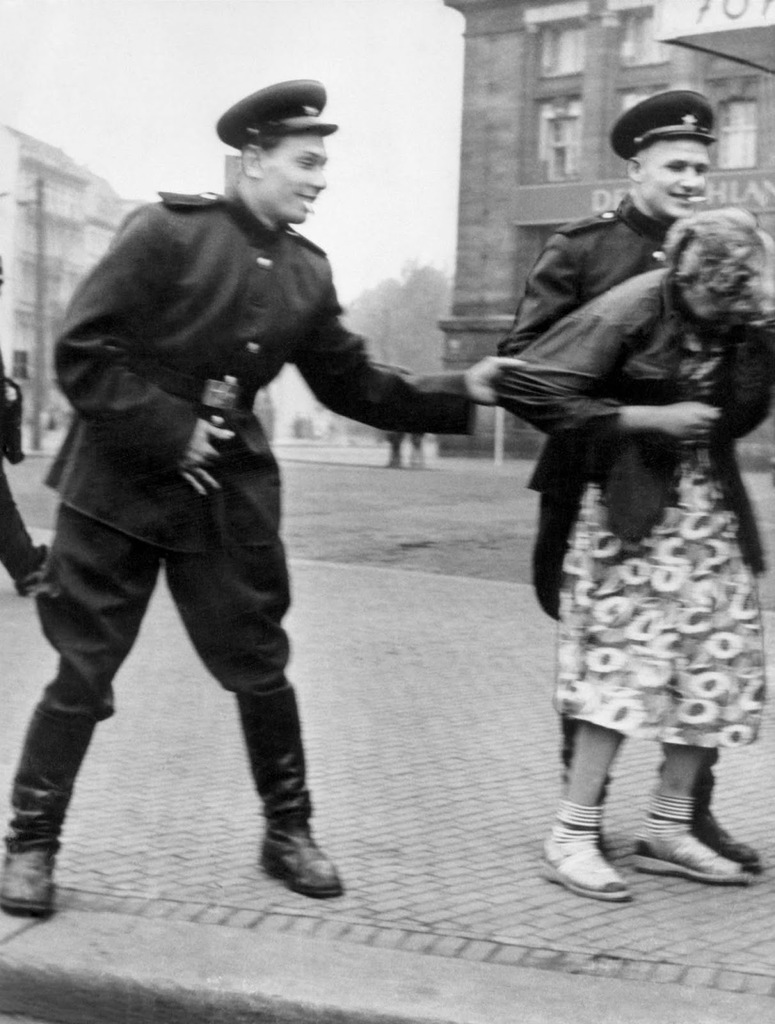 Soviet soldiers openly sexually harass a German woman in Leipzig, 1945. Soviet soldiers openly sexually harass a passing German woman near the West Hall section of the Leipzig Hauptbahnhof central railway terminus. As Allied troops entered and occupied German territory during the later stages of the war, mass rapes took place both in connection with combat operations and during the subsequent occupation. The victims not only bore the brunt of revenge for Wehrmacht crimes, they also represented an atavistic target as old as war itself. Rape is the act of a conqueror, the historian Susan Brownmiller observed, aimed at the “bodies of the defeated enemy’s women” to emphasize his victory. Most historians agree, although the issue is contentious, that the majority of the sexual assaults on German female civilians were committed in the Soviet occupation zone; estimates of the numbers of German women raped by Soviet soldiers have ranged up to 2 million. In many cases women were the victims of repeated rapes, some as many as 60 to 70 times. At least 100,000 women are believed to have been raped in Berlin, based on surging abortion rates in the following months and contemporary hospital reports, with an estimated 10,000 women dying in the aftermath. Female deaths in connection with sexual assaults in Germany, overall, are estimated at 240,000. War historians have described it as the “greatest phenomenon of mass rape in history”, and have concluded that at least 1.4 million women were raped in East Prussia, Pomerania and Silesia alone. The novelist Vasily Grossman, a war correspondent attached to the invading Red Army, soon discovered that rape victims were not just Germans. Polish women also suffered. So did young Russian, Belorussian and Ukrainian women who had been sent back to Germany by the Wehrmacht for slave labour. “Liberated Soviet girls quite often complain that our soldiers rape them”, he noted. “One girl said to me in tears: He was an old man, older than my father”.
Soviet soldiers openly sexually harass a German woman in Leipzig, 1945. Soviet soldiers openly sexually harass a passing German woman near the West Hall section of the Leipzig Hauptbahnhof central railway terminus. As Allied troops entered and occupied German territory during the later stages of the war, mass rapes took place both in connection with combat operations and during the subsequent occupation. The victims not only bore the brunt of revenge for Wehrmacht crimes, they also represented an atavistic target as old as war itself. Rape is the act of a conqueror, the historian Susan Brownmiller observed, aimed at the “bodies of the defeated enemy’s women” to emphasize his victory. Most historians agree, although the issue is contentious, that the majority of the sexual assaults on German female civilians were committed in the Soviet occupation zone; estimates of the numbers of German women raped by Soviet soldiers have ranged up to 2 million. In many cases women were the victims of repeated rapes, some as many as 60 to 70 times. At least 100,000 women are believed to have been raped in Berlin, based on surging abortion rates in the following months and contemporary hospital reports, with an estimated 10,000 women dying in the aftermath. Female deaths in connection with sexual assaults in Germany, overall, are estimated at 240,000. War historians have described it as the “greatest phenomenon of mass rape in history”, and have concluded that at least 1.4 million women were raped in East Prussia, Pomerania and Silesia alone. The novelist Vasily Grossman, a war correspondent attached to the invading Red Army, soon discovered that rape victims were not just Germans. Polish women also suffered. So did young Russian, Belorussian and Ukrainian women who had been sent back to Germany by the Wehrmacht for slave labour. “Liberated Soviet girls quite often complain that our soldiers rape them”, he noted. “One girl said to me in tears: He was an old man, older than my father”. -
6.
![Last picture of Nikola Tesla, 1943.
According to “Tesla – Master of Lightning” this is the last photograph taken of Tesla before his death.
By the end of his brilliant and tortured life, the famous physicist, engineer and inventor Nikola Tesla was penniless and living in a small New York City hotel room. He had become a vegetarian at that point in his life and lived on only milk, bread, honey, and vegetable juices. Tesla spent days in a park surrounded by the creatures that mattered most to him—pigeons—and his sleepless nights working over mathematical equations and scientific problems in his head.
On 7 January 1943, at the age of 86, Tesla died alone in room 3327 of the New Yorker Hotel. His body was later found by maid Alice Monaghan after she had entered Tesla’s room, ignoring the “do not disturb” sign that Tesla had placed on his door two days earlier. Assistant medical examiner H.W. Wembly examined the body and ruled that the cause of death had been coronary thrombosis. Tesla’s remains were taken to the Frank E. Campbell Funeral Home at Madison Ave. and 81st St. A long-time friend and supporter of Tesla, Hugo Gernsback, commissioned a sculptor to create a death mask, now displayed in the Nikola Tesla Museum.
Two days later the FBI ordered the Alien Property Custodian to seize Tesla’s belongings, even though Tesla was an American citizen. Tesla’s entire estate from the Hotel New Yorker and other New York City hotels was transported to the Manhattan Storage and Warehouse Company under the Office of Alien Property (OAP) seal. John G. Trump, a professor at M.I.T. and a well-known electrical engineer serving as a technical aide to the National Defense Research Committee, was called in to analyze the Tesla items in OAP custody.
After a three-day investigation, Trump’s report concluded that there was nothing which would constitute a hazard in unfriendly hands, stating: “[Tesla’s] thoughts and efforts during at least the past 15 years were primarily of a speculative, philosophical, and somewhat promotional character often concerned with the production and wireless transmission of power; but did not include new, sound, workable principles or methods for realizing such results”.
On 10 January 1943 New York City mayor Fiorello La Guardia read a eulogy written by Slovene-American author Louis Adamic live over the WNYC radio while violin pieces “Ave Maria” and “Tamo daleko” were played in the background. On 12 January, two thousand people attended a state funeral for Tesla at the Cathedral of Saint John the Divine. After the funeral, Tesla’s body was taken to the Ferncliff Cemetery in Ardsley, New York, where it was later cremated. The following day, a second service was conducted by prominent priests in the Trinity Chapel in New York City.](https://cdn.ebaumsworld.com/mediaFiles/picture/604025/85174198.jpg) Last picture of Nikola Tesla, 1943. According to “Tesla – Master of Lightning” this is the last photograph taken of Tesla before his death. By the end of his brilliant and tortured life, the famous physicist, engineer and inventor Nikola Tesla was penniless and living in a small New York City hotel room. He had become a vegetarian at that point in his life and lived on only milk, bread, honey, and vegetable juices. Tesla spent days in a park surrounded by the creatures that mattered most to him—pigeons—and his sleepless nights working over mathematical equations and scientific problems in his head. On 7 January 1943, at the age of 86, Tesla died alone in room 3327 of the New Yorker Hotel. His body was later found by maid Alice Monaghan after she had entered Tesla’s room, ignoring the “do not disturb” sign that Tesla had placed on his door two days earlier. Assistant medical examiner H.W. Wembly examined the body and ruled that the cause of death had been coronary thrombosis. Tesla’s remains were taken to the Frank E. Campbell Funeral Home at Madison Ave. and 81st St. A long-time friend and supporter of Tesla, Hugo Gernsback, commissioned a sculptor to create a death mask, now displayed in the Nikola Tesla Museum. Two days later the FBI ordered the Alien Property Custodian to seize Tesla’s belongings, even though Tesla was an American citizen. Tesla’s entire estate from the Hotel New Yorker and other New York City hotels was transported to the Manhattan Storage and Warehouse Company under the Office of Alien Property (OAP) seal. John G. Trump, a professor at M.I.T. and a well-known electrical engineer serving as a technical aide to the National Defense Research Committee, was called in to analyze the Tesla items in OAP custody. After a three-day investigation, Trump’s report concluded that there was nothing which would constitute a hazard in unfriendly hands, stating: “[Tesla’s] thoughts and efforts during at least the past 15 years were primarily of a speculative, philosophical, and somewhat promotional character often concerned with the production and wireless transmission of power; but did not include new, sound, workable principles or methods for realizing such results”. On 10 January 1943 New York City mayor Fiorello La Guardia read a eulogy written by Slovene-American author Louis Adamic live over the WNYC radio while violin pieces “Ave Maria” and “Tamo daleko” were played in the background. On 12 January, two thousand people attended a state funeral for Tesla at the Cathedral of Saint John the Divine. After the funeral, Tesla’s body was taken to the Ferncliff Cemetery in Ardsley, New York, where it was later cremated. The following day, a second service was conducted by prominent priests in the Trinity Chapel in New York City.
Last picture of Nikola Tesla, 1943. According to “Tesla – Master of Lightning” this is the last photograph taken of Tesla before his death. By the end of his brilliant and tortured life, the famous physicist, engineer and inventor Nikola Tesla was penniless and living in a small New York City hotel room. He had become a vegetarian at that point in his life and lived on only milk, bread, honey, and vegetable juices. Tesla spent days in a park surrounded by the creatures that mattered most to him—pigeons—and his sleepless nights working over mathematical equations and scientific problems in his head. On 7 January 1943, at the age of 86, Tesla died alone in room 3327 of the New Yorker Hotel. His body was later found by maid Alice Monaghan after she had entered Tesla’s room, ignoring the “do not disturb” sign that Tesla had placed on his door two days earlier. Assistant medical examiner H.W. Wembly examined the body and ruled that the cause of death had been coronary thrombosis. Tesla’s remains were taken to the Frank E. Campbell Funeral Home at Madison Ave. and 81st St. A long-time friend and supporter of Tesla, Hugo Gernsback, commissioned a sculptor to create a death mask, now displayed in the Nikola Tesla Museum. Two days later the FBI ordered the Alien Property Custodian to seize Tesla’s belongings, even though Tesla was an American citizen. Tesla’s entire estate from the Hotel New Yorker and other New York City hotels was transported to the Manhattan Storage and Warehouse Company under the Office of Alien Property (OAP) seal. John G. Trump, a professor at M.I.T. and a well-known electrical engineer serving as a technical aide to the National Defense Research Committee, was called in to analyze the Tesla items in OAP custody. After a three-day investigation, Trump’s report concluded that there was nothing which would constitute a hazard in unfriendly hands, stating: “[Tesla’s] thoughts and efforts during at least the past 15 years were primarily of a speculative, philosophical, and somewhat promotional character often concerned with the production and wireless transmission of power; but did not include new, sound, workable principles or methods for realizing such results”. On 10 January 1943 New York City mayor Fiorello La Guardia read a eulogy written by Slovene-American author Louis Adamic live over the WNYC radio while violin pieces “Ave Maria” and “Tamo daleko” were played in the background. On 12 January, two thousand people attended a state funeral for Tesla at the Cathedral of Saint John the Divine. After the funeral, Tesla’s body was taken to the Ferncliff Cemetery in Ardsley, New York, where it was later cremated. The following day, a second service was conducted by prominent priests in the Trinity Chapel in New York City. -
7.
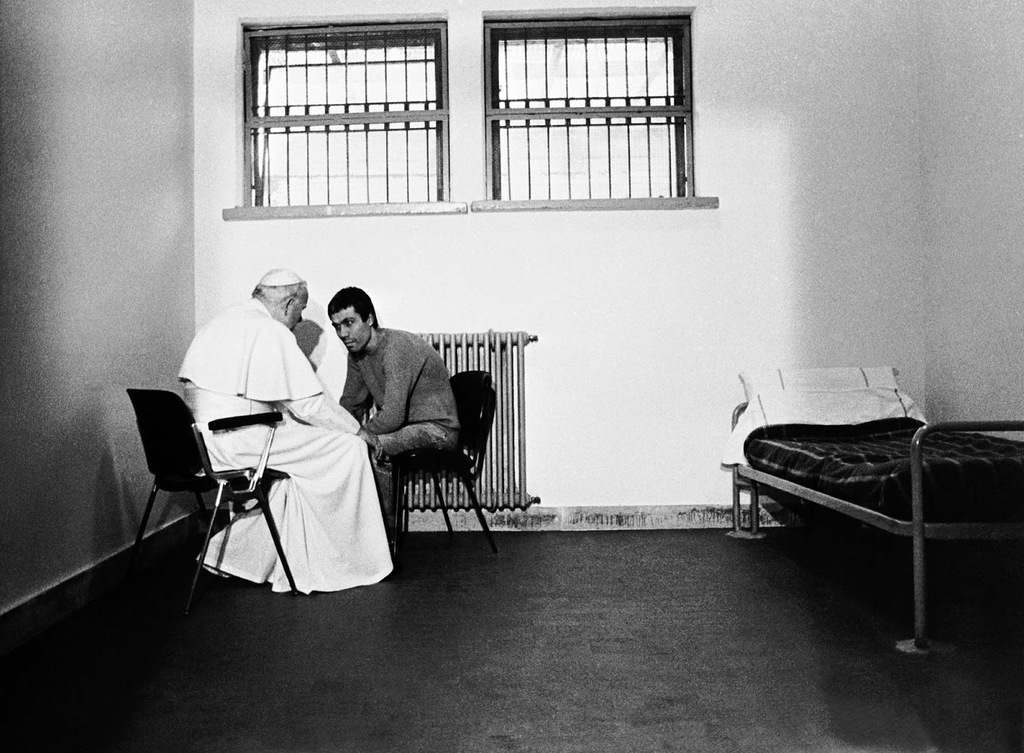 Pope John Paul II meets with Mehmet Agca, the man who attempted to assassinate him, 1983. On Wednesday, May 13, 1981, Mehmet Ali Agca pulled a gun and shot Pope John Paul II during a procession in St. Peter’s Square, Vatican City, Italy. Though critically wounded, the Pope survived four gunshot wounds to his abdomen. Following the shooting, Pope John Paul II asked people to “pray for my brother…whom I have sincerely forgiven”. In 1983, Pope John Paul II and Agca met and spoke privately at the prison where Agca was being held. The Pope brought the photographer and the cameramen because he wanted the image in that cell to be shown around a world filled witt unforgiving hatreds, with hostile superpowers and smaller, implacable fanaticism. When the Pope arrived in his cell, Agca was dressed in a blue crewneck sweater, jeans and blue-and-white running shoes from which the laces had been removed. He was unshaved. Agca kissed John Paul’s hand. “Do you speak Italian?” the Pope asked. Agca nodded. For 21 minutes, the two men seated themselves, close together, on molded-plastic chairs in a corner of the cell, out of earshot. As John Paul rose to leave, the two men shook hands. The Pope gave Agca a small gift in a white box, a rosary in silver and mother-of-pearl. The Pope walked out. Agca was left standing alone, and the camera recorded a sudden look of uncertainty on his face. Perhaps he was thinking about the prospect of spending the rest of his life in jail for attempting to kill a man he did not know, a man who now came to him as a friend. Agca was sentenced, in July 1981, to life imprisonment in Italy for the assassination attempt, but was pardoned by president Carlo Azeglio Ciampi in June 2000 at the Pope’s request. He was then extradited to Turkey, where he was imprisoned for the 1979 murder of left-wing journalist Abdi İpekçi and two bank raids carried out in the 1970s. Despite a plea for early release in November 2004, a Turkish court announced that he would not be eligible for release until 2010. Nonetheless he was released on parole on 12 January 2006. However, on 20 January 2006, the Turkish Supreme Court ruled that his time served in Italy could not be deducted from his Turkish sentence and he was returned to jail. Ağca was released from prison on 18 January 2010, after almost 29 years behind bars.
Pope John Paul II meets with Mehmet Agca, the man who attempted to assassinate him, 1983. On Wednesday, May 13, 1981, Mehmet Ali Agca pulled a gun and shot Pope John Paul II during a procession in St. Peter’s Square, Vatican City, Italy. Though critically wounded, the Pope survived four gunshot wounds to his abdomen. Following the shooting, Pope John Paul II asked people to “pray for my brother…whom I have sincerely forgiven”. In 1983, Pope John Paul II and Agca met and spoke privately at the prison where Agca was being held. The Pope brought the photographer and the cameramen because he wanted the image in that cell to be shown around a world filled witt unforgiving hatreds, with hostile superpowers and smaller, implacable fanaticism. When the Pope arrived in his cell, Agca was dressed in a blue crewneck sweater, jeans and blue-and-white running shoes from which the laces had been removed. He was unshaved. Agca kissed John Paul’s hand. “Do you speak Italian?” the Pope asked. Agca nodded. For 21 minutes, the two men seated themselves, close together, on molded-plastic chairs in a corner of the cell, out of earshot. As John Paul rose to leave, the two men shook hands. The Pope gave Agca a small gift in a white box, a rosary in silver and mother-of-pearl. The Pope walked out. Agca was left standing alone, and the camera recorded a sudden look of uncertainty on his face. Perhaps he was thinking about the prospect of spending the rest of his life in jail for attempting to kill a man he did not know, a man who now came to him as a friend. Agca was sentenced, in July 1981, to life imprisonment in Italy for the assassination attempt, but was pardoned by president Carlo Azeglio Ciampi in June 2000 at the Pope’s request. He was then extradited to Turkey, where he was imprisoned for the 1979 murder of left-wing journalist Abdi İpekçi and two bank raids carried out in the 1970s. Despite a plea for early release in November 2004, a Turkish court announced that he would not be eligible for release until 2010. Nonetheless he was released on parole on 12 January 2006. However, on 20 January 2006, the Turkish Supreme Court ruled that his time served in Italy could not be deducted from his Turkish sentence and he was returned to jail. Ağca was released from prison on 18 January 2010, after almost 29 years behind bars. -
8.
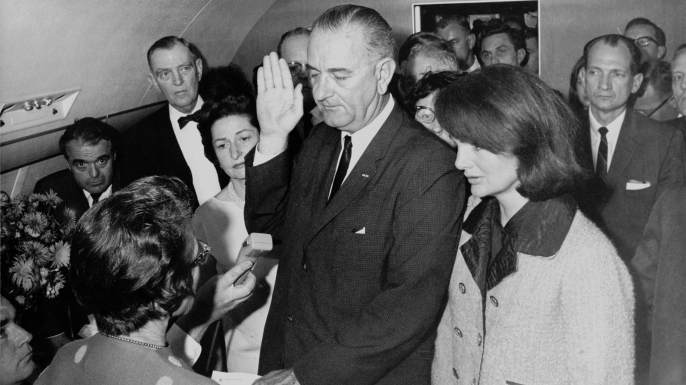 Lyndon Johnson, 1963, Air Force One. Two hours after President John F. Kennedy was assassinated on November 22, 1963, Vice President Lyndon Johnson was sworn in as the nation’s 36th president aboard Air Force One at Dallas’ Love Field. Cecil Stoughton, a former Army photographer who had served as the official White House photographer since 1961 (the first person to hold the post), took the historic photo of Judge Sarah Hughes administering the oath of office to a solemn Johnson, flanked by his wife, a group of staffers and a stunned-looking Jaqueline Kennedy, still clad in the pink Chanel suit she was wearing when her husband was shot. At the time of Kennedy’s assassination, Stoughton was riding several cars behind the president as part of his motorcade. Afterward, Stoughton went to Parkland Hospital, where Kennedy died, then raced to Love Field for Johnson’s swearing-in. Stoughton was the only photographer on the plane when Johnson was inaugurated and initially, when his camera malfunctioned, it appeared there wouldn’t be any photographic record. However, he quickly fixed the problem and was able to document the event. In a chaotic time for America, Stoughton’s photograph demonstrated the country still had continuity of government.
Lyndon Johnson, 1963, Air Force One. Two hours after President John F. Kennedy was assassinated on November 22, 1963, Vice President Lyndon Johnson was sworn in as the nation’s 36th president aboard Air Force One at Dallas’ Love Field. Cecil Stoughton, a former Army photographer who had served as the official White House photographer since 1961 (the first person to hold the post), took the historic photo of Judge Sarah Hughes administering the oath of office to a solemn Johnson, flanked by his wife, a group of staffers and a stunned-looking Jaqueline Kennedy, still clad in the pink Chanel suit she was wearing when her husband was shot. At the time of Kennedy’s assassination, Stoughton was riding several cars behind the president as part of his motorcade. Afterward, Stoughton went to Parkland Hospital, where Kennedy died, then raced to Love Field for Johnson’s swearing-in. Stoughton was the only photographer on the plane when Johnson was inaugurated and initially, when his camera malfunctioned, it appeared there wouldn’t be any photographic record. However, he quickly fixed the problem and was able to document the event. In a chaotic time for America, Stoughton’s photograph demonstrated the country still had continuity of government. -
9.
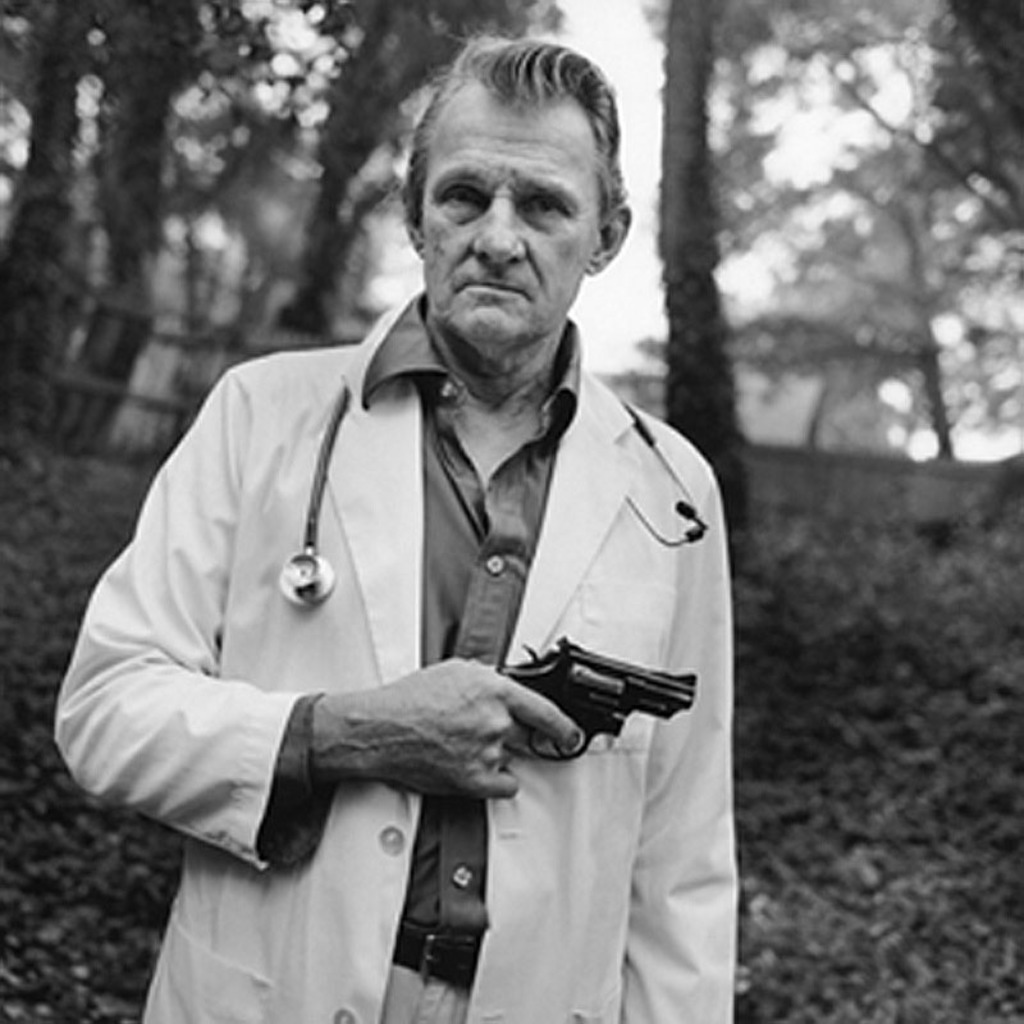 Dr. John Britton with the .357 Magnum he carried for protection when visiting the Pensacola Ladies’ Centre to perform abortions. John Bayard Britton was an American physician who was murdered in Pensacola, Florida, by anti-abortion extremist Paul Jennings Hill. Britton’s death was the second assassination of a Pensacola abortion provider in under a year and a half; he had replaced David Gunn after the latter’s 1993 murder by another anti-abortionist. After Gunn’s murder, Britton began flying across the state to Pensacola weekly in order to perform abortions at the Pensacola Ladies’ Center. Because he had received harassment and death threats, he wore a homemade bulletproof vest, carried a .357 Magnum, and enlisted volunteer bodyguards. Britton was notably ambivalent about abortion: he was vocal about his personal opposition to the procedure, and would sometimes turn away women seeking it, telling them to think about the decision and come back in a week if they still wanted an abortion. However, he described anti-abortion protesters as “fanatics”. As Britton arrived at the clinic on July 29, 1994, Hill approached and fired on him with a twelve-gauge shotgun, hitting him in the head and killing Britton, aged 69. Hill later stated that he aimed for Dr. Britton’s head because he suspected the doctor was wearing a bulletproof vest. Hill also killed Britton’s bodyguard, a retired Air Force lieutenant colonel, James Barrett (aged 74), and wounded Barrett’s wife, June, a retired nurse. The murder resulted in several members of Congress calling for the FBI to infiltrate anti-abortion groups, as it had with the Ku Klux Klan. Hill was sentenced to death on December 6, 1994 and executed by lethal injection on September 3, 2003. He was the first person in the United States to be executed for murdering a doctor who performed abortions.
Dr. John Britton with the .357 Magnum he carried for protection when visiting the Pensacola Ladies’ Centre to perform abortions. John Bayard Britton was an American physician who was murdered in Pensacola, Florida, by anti-abortion extremist Paul Jennings Hill. Britton’s death was the second assassination of a Pensacola abortion provider in under a year and a half; he had replaced David Gunn after the latter’s 1993 murder by another anti-abortionist. After Gunn’s murder, Britton began flying across the state to Pensacola weekly in order to perform abortions at the Pensacola Ladies’ Center. Because he had received harassment and death threats, he wore a homemade bulletproof vest, carried a .357 Magnum, and enlisted volunteer bodyguards. Britton was notably ambivalent about abortion: he was vocal about his personal opposition to the procedure, and would sometimes turn away women seeking it, telling them to think about the decision and come back in a week if they still wanted an abortion. However, he described anti-abortion protesters as “fanatics”. As Britton arrived at the clinic on July 29, 1994, Hill approached and fired on him with a twelve-gauge shotgun, hitting him in the head and killing Britton, aged 69. Hill later stated that he aimed for Dr. Britton’s head because he suspected the doctor was wearing a bulletproof vest. Hill also killed Britton’s bodyguard, a retired Air Force lieutenant colonel, James Barrett (aged 74), and wounded Barrett’s wife, June, a retired nurse. The murder resulted in several members of Congress calling for the FBI to infiltrate anti-abortion groups, as it had with the Ku Klux Klan. Hill was sentenced to death on December 6, 1994 and executed by lethal injection on September 3, 2003. He was the first person in the United States to be executed for murdering a doctor who performed abortions. -
10.
![“The Situation Room,” 2011, White House.
Taken on the afternoon of May 1, 2011, this image shows President Barack Obama and his national security team receiving updates about the top-secret Navy SEAL raid on the Pakistani compound of one of the most-wanted men in U.S. history, al-Qaeda leader Osama bin Laden. At 11:35 ET that night, the president appeared on live TV to announce that the mastermind behind the 9/11 terrorist attacks had been killed by the SEALs.
White House photographer Pete Souza snapped the photo after Obama and his senior aides had crowded into a small conference room in the West Wing’s Situation Room complex, where Brigadier General Marshall “Brad” Webb was monitoring the mission. When Obama entered the room, Webb offered the president his chair. However, as Obama told NBC News, “ I said, ‘You don’t worry about it. You just focus on what you’re doing. I’m sure we can find a chair and I’ll sit right next to him.’ And that’s how I ended up [on a] folding chair.” Obama later referred to the high-stakes raid, during which a SEAL helicopter crash-landed at bin Laden’s hideout, as the longest 40 minutes of his life, while Secretary of State Hillary Clinton said she’d been concentrating so intensely while monitoring the raid that she hadn’t been aware the White House photographer was taking pictures.](https://cdn.ebaumsworld.com/mediaFiles/picture/604025/85174202.jpg) “The Situation Room,” 2011, White House. Taken on the afternoon of May 1, 2011, this image shows President Barack Obama and his national security team receiving updates about the top-secret Navy SEAL raid on the Pakistani compound of one of the most-wanted men in U.S. history, al-Qaeda leader Osama bin Laden. At 11:35 ET that night, the president appeared on live TV to announce that the mastermind behind the 9/11 terrorist attacks had been killed by the SEALs. White House photographer Pete Souza snapped the photo after Obama and his senior aides had crowded into a small conference room in the West Wing’s Situation Room complex, where Brigadier General Marshall “Brad” Webb was monitoring the mission. When Obama entered the room, Webb offered the president his chair. However, as Obama told NBC News, “ I said, ‘You don’t worry about it. You just focus on what you’re doing. I’m sure we can find a chair and I’ll sit right next to him.’ And that’s how I ended up [on a] folding chair.” Obama later referred to the high-stakes raid, during which a SEAL helicopter crash-landed at bin Laden’s hideout, as the longest 40 minutes of his life, while Secretary of State Hillary Clinton said she’d been concentrating so intensely while monitoring the raid that she hadn’t been aware the White House photographer was taking pictures.
“The Situation Room,” 2011, White House. Taken on the afternoon of May 1, 2011, this image shows President Barack Obama and his national security team receiving updates about the top-secret Navy SEAL raid on the Pakistani compound of one of the most-wanted men in U.S. history, al-Qaeda leader Osama bin Laden. At 11:35 ET that night, the president appeared on live TV to announce that the mastermind behind the 9/11 terrorist attacks had been killed by the SEALs. White House photographer Pete Souza snapped the photo after Obama and his senior aides had crowded into a small conference room in the West Wing’s Situation Room complex, where Brigadier General Marshall “Brad” Webb was monitoring the mission. When Obama entered the room, Webb offered the president his chair. However, as Obama told NBC News, “ I said, ‘You don’t worry about it. You just focus on what you’re doing. I’m sure we can find a chair and I’ll sit right next to him.’ And that’s how I ended up [on a] folding chair.” Obama later referred to the high-stakes raid, during which a SEAL helicopter crash-landed at bin Laden’s hideout, as the longest 40 minutes of his life, while Secretary of State Hillary Clinton said she’d been concentrating so intensely while monitoring the raid that she hadn’t been aware the White House photographer was taking pictures.
- NEXT GALLERY
-

- 25 Future Darwin Award Nominees Will Make You Cringe
Street vendor selling mummies in Egypt, 1865. During the Victorian era of 1800’s, Napoleon’s conquest of Egypt threw open the Gates of Egypt’s history for the Europeans. At that time, mummies were not accorded the respect that they deserved from the European elites and in fact, mummies could be purchased from street vendors (as shown in picture) to be used as the main event for parties and social gatherings that took place in the 18th century. The elites of the era would often hold “Mummy Unwrapping Parties”, which, as the name suggests, had the main theme in which a Mummy would be unwrapped in front of a boisterous audience, cheering and applauding at the same time. During that period of time, the well-preserved remains of ancient Egyptians were routinely ground into powder and consumed as a medicinal remedy. Indeed, so popular was pulverized mummy that it even instigated a counterfeit trade to meet demand, in which the flesh of beggars was passed off as that of ancient mummified Egyptians. As the Industrial Revolution progressed, so Egyptian mummies were exploited for more utilitarian purposes: huge numbers of human and animal mummies were ground up and shipped to Britain and Germany for use as fertilizer. Others were used to create mummy brown pigment or were stripped of their wrappings, which were subsequently exported to the US for use in the paper-making industry. The author Mark Twain even reported that mummies were burnt in Egypt as locomotive fuel. As the nineteenth century advanced, mummies became prized objects of display and scores of them were purchased by wealthy European and American private collectors as tourist souvenirs. For those who could not afford a whole mummy, disarticulated remains – such as a head, hand or foot – could be purchased on the black market and smuggled back home. So brisk was the trade in mummies to Europe that even after ransacking tombs and catacombs there just were not enough ancient Egyptian bodies to meet the demand. And so fake mummies were fabricated from the corpses of the executed criminals, the aged, the poor and those who had died from hideous diseases, by burying them in the sand or stuffing them with bitumen and exposing them to the sun.
10/10
1/10
Categories:
Wow


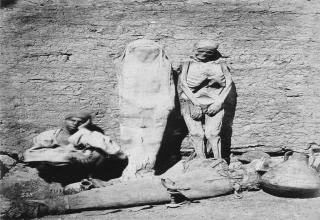

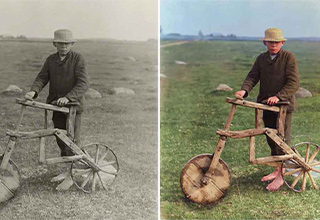


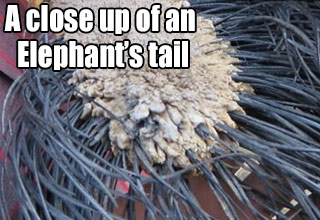

0 Comments